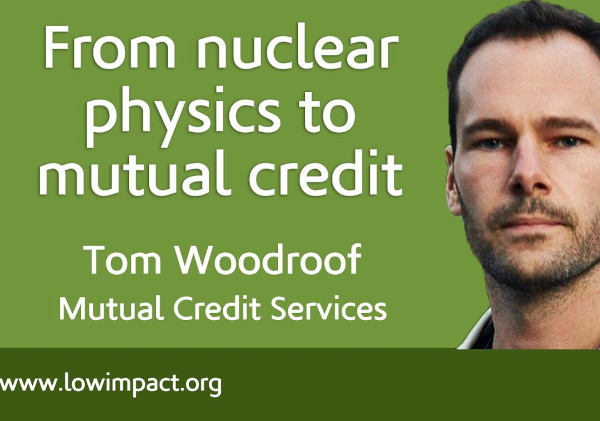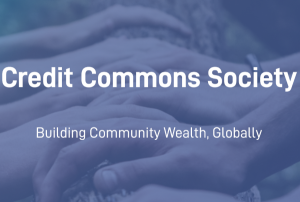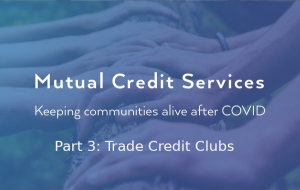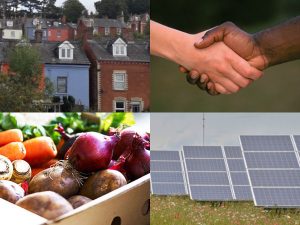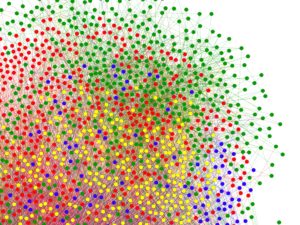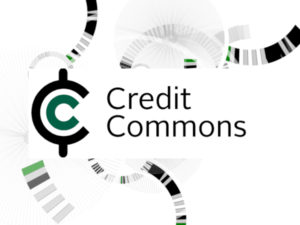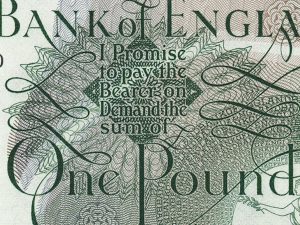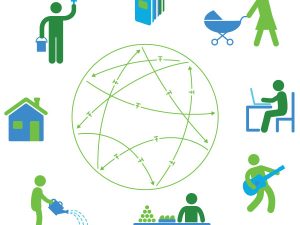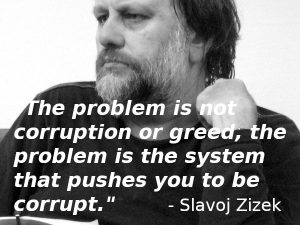This is Part 1 of an interview with Tom Woodroof of Mutual Credit Services, who made the shift from the world of nuclear physics to the world of mutual credit. Part 2 is here.
Hi Tom. At Lowimpact we believe that the mutual credit family of ideas will form the basis of the emerging commons economy, so we’re very interested in why you made that huge move, and what you’re up to now. You’re working with Dil Green and others at Mutual Credit Services, you’re part of the Credit Commons Society team, and you’ve joined Lowimpact too – in fact you’re going to be on the other side of these interviews soon – doing the interviewing.
First, tell us about the nuclear physics world – how did you get into it and what were you doing?
I did my undergrad degree in physics at Manchester. The nuclear physics and thermodynamics modules interested me most. I got fascinated by the range of things an atomic nucleus could look like – the boundary between classical physics and quantum physics. You can understand the ideas via the ‘common sense’ of classical physics, but quantum effects bring up lots of interesting phenomena. I found quite a practical PhD, working with gamma radiation detectors, to try to understand the dynamics of radioactive fallout in the environment – for example, around Fukushima or Chernobyl.
Talk us through the process – why and how did you make the change to mutual credit?
Through your writing, and the writings of Dil Green.
So it’s my fault?
Exactly. I’d spent most of my adult life trying to work out how the world works, and what’s going on. The more I understood, I couldn’t believe that everyone wasn’t running around panicking. I came across Lowimpact in 2017, when I was about half-way through my PhD. I’d read about community currencies before, but not mutual credit. I knew that money had something to do with the predicament we’re in. I found that mutual credit made the connections I’d been looking for, between money, economy, society and environment, in ways that no-one else was talking about.
I finished my PhD at the end of 2019, did a brief stint at the Institute for Cancer Research, but decided that it wasn’t for me, by which time I’d become involved in XR. Lockdowns gave me more time to look into the mutual credit world, and I decided to try to get involved. I contacted you and Dil, explained that I didn’t have a background in finance or economics, and was there a way to make myself useful? In June 2020 I was invited to join the initial collaboration group that was forming Mutual Credit Services.
What was it about mutual credit that grabbed your attention?
I’d read a lot of interesting analysis of money and the problems it causes, but the writings on mutual credit gave me an insight into what money actually was, and the idea that it can be designed differently. I was aware that money has evolved, and taken on different forms, from clay tablets to coins, paper and now digital money.
I hadn’t seen the design of money linked to the potential for system change anywhere else. I saw how a different system could emerge if exchange and investment were underpinned by different forms of money. This was new and exciting.
Do you see mutual credit as money? I always refer to it as moneyless trading.
It’s not money as we know it. Money is understood in many different ways. Credit is a much clearer term, I think. When I use the term moneyless trade, I find that people assume you’re talking about barter, and I have to explain that mutual credit is a form of barter – but a multilateral form – after which you can become a bit trapped in the weeds of various definitions, and lose the interesting ideas. Moneyless trade is true, and useful in various contexts, but it’s not where I tend to start.
Yes. If mutual credit is a form of money, it’s not the kind you can put in a bag with ‘swag’ written on it. It’s more of an accounting system.
Exactly. It’s accounting for exchange. Dil and I talk a lot about how we can communicate these ideas to different audiences, to give ourselves the best chance of having a constructive conversation. You have to judge the audience. Brett Scott writes interestingly about this. As you say, a good distinction is between the kind of money you can put in a bag – something you can think of as a ‘thing’, or a commodity – versus a form of credit. For the right audience, that’s a great place to start. But for most people, it’s too abstract.
I think you’re right – talking about a moneyless trading system can confuse people. But for people who don’t have much money, or no money at all, the word ‘moneyless’ makes them sit up and take notice.
That’s true. But the best 30-second elevator pitch we’ve been able to come up with is that we’re adapting tools developed by the banks and the finance sector for managing cashflow, and making them available in the real economy – business networks and communities. People associate banks with money, but there’s this long history of banks trying to avoid the use of money between themselves – because even for them, it’s expensive. They’ve come up with lots of ways to operate without using money. In the jargon, they’re called ‘liquidity saving mechanisms’. But these mechanisms aren’t made available to ordinary people / small businesses. That tends to get people interested.
Yes, I guess people think that if the banks do it, it’s not so wacky or radical, and it must be profitable, because they haven’t done too badly.
Yes. Not that everything the banks do makes sense. We’ve seen since 2008 that that’s not true. But as you say, they seem to be doing alright for themselves. We discovered the work of Tomaž Fleischmann, who’s been working on liquidity saving mechanisms at the national scale in Slovenia for decades, and we saw that it might be counterproductive to describe ourselves in radical, edgy terms, when actually, it’s been happening in the financial mainstream for a long time. All we’re doing is adapting them and making them available to everyone else. We’re actually working closely with Tomaž now, on the Local Loop project in Lancaster, bringing liquidity-saving mechanisms to the local scale rather than the national scale.
I’ll come back to that. First, let’s talk about your work at Mutual Credit Services – what’s the problem you’re trying to solve?
Well, solve is probably too strong a word. Maybe ‘address’ is better. I was drawn in by the kinds of things you write about – sustainability, inequality, preparing for the coming crash, and trying to build adaptive capacity for when the bubble inevitably bursts. But resilience, adaptation and healthier emergent outcomes are not something you can build. We’ve got to build concrete infrastructure that makes it possible for those outcomes to emerge.
First we have to improve our own understanding of different liquidity-saving mechanisms and these various techniques for moneyless exchange, of which mutual credit is one, and build platforms using these techniques that ordinary people can engage with, and which provides them with immediate, clear benefits – and finally, to communicate these ideas in ways that attract people, rather than scaring them off.
Would it be fair to say that you see the mutual credit ‘family’ of ideas as lifeboats that can keep people afloat if the economy crashes?
If we can build platforms that people can use – that can become part of people’s lives. If a community had a functional mutual credit network, it would provide them with a degree of insulation from wider financial crises. This has been demonstrated in peer-reviewed literature, by Jim Stodder, for example, who studied the Wir Bank in Switzerland, that’s been around since 1934. He’s shown clearly that although it comprises only 1-2% of the Swiss economy, it does have a macro stabilising effect when there are wider economic downturns. So yes, I guess a lifeboat isn’t a bad way of looking at it.
Also interesting is the effect it can have on relocalising the economy – driving import substitution. I see that the outcomes that mutual credit and related ideas drive will lead to a significant increase in the ability to adapt.
So you’re building a range of tools, but community building is the most important thing – or there won’t be anywhere to use those tools?
Yes. We were a bit critical of projects that stressed ‘making the world a better place’ without thinking enough about why people would participate in the first place. When the novelty and initial enthusiasm run out, these projects always fail. With everything we do, we want to make it very clear from the start why individuals would want to participate in it. The ‘what’s in it for me?’ question.
But we’ve also found that local authorities like to talk about community wealth building, circular economy and building resilience, so we’ve realised that we can cover both these areas. We need to show people how these tools will benefit them, but not be afraid of saying that communities will benefit too. The emphasis depends on who we’re talking to.
Yes, a lot of projects rely entirely on altruism. But also, it needs to bring benefits to people in working class communities. It makes me wonder what percentage of the world is driven by altruism, and I don’t think it’s that high, really.
I think a lot more people might be driven by altruism if they had the chance. But economic conditions mean that fewer and fewer of us can afford that. If you’re offering things that are actually going to make people’s lives economically harder, then you’re not going to get anywhere. I don’t think (as in classical economics) that people are driven entirely by self-interest, but as things get worse, offering things that don’t have economic benefits are not going to fly.
Highlights
- I found that mutual credit made the connections I’d been looking for, between money, economy, society and environment, in ways that no-one else was talking about.
- We’re adapting tools developed by the banks and the finance sector for moneyless exchange, and making them available in the real economy – business networks and communities.
- We need to show people how these tools will benefit them, but not be afraid of saying that communities will benefit too. The emphasis depends on who we’re talking to.
In Part 2, we talk about the range of new monetary tools that are being developed, that can help build a completely new, ‘commons’ economy.

